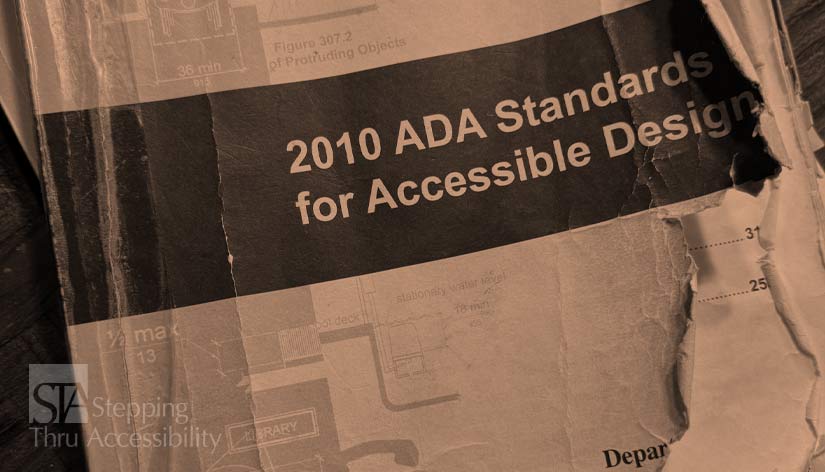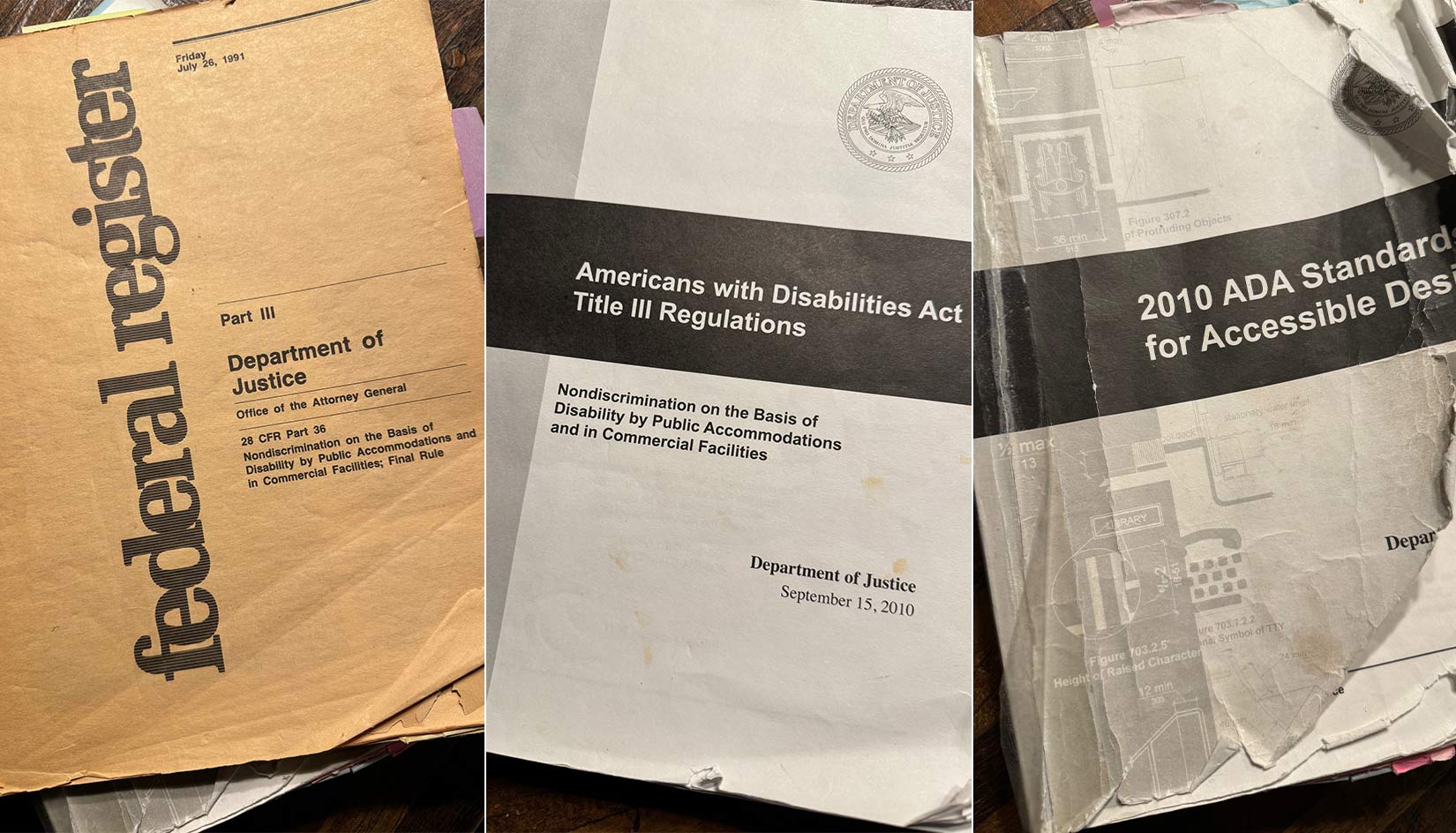Blog
Return to Blog »
Janis Kent, Architect, FAIA, CASp © February 2024 Many times, as architects, we rely on codes to direct us as to what needs to be implemented in terms of Access. Some may go one step further and also go into the implementing regulations. But what are the differences between the Americans with Disabilities Act (ADA) and codes and regulations (federal or state), and how do they integrate with each other? Let’s start with the ADA of 1990. As most know, this is a civil rights act that was put into effect by Congress and enacted on July 26, 1990. The following year, the Department of Justice (DOJ) published a notice of proposed rulemaking (NPRM). Comments were received and analyzed. The US Access Board, as an independent agency, developed design criteria, one of which is for the built environment and is intended to be applied during construction and alterations of buildings and facilities. These guidelines were initially based on Uniform Federal Accessibility Standards (UFAS) which came from portions of the American National Standards Institute (ANSI) A117.1, the 1980 edition. The Access Board developed the ADA Accessibility Guidelines, (ADAAG), which DOJ modified and expanded when they actually adopted it and made it binding in the implementing regulations. The final rulemaking for §§ 28 CFR Parts 35 and 36 was implemented by DOJ and effective as of January 26, 1992, which are known as the final regulations. In 2004, the US Access Board published the ADA and ABA Accessibility Guidelines by merging guidelines for Title II, Title III, and the federal ABA for better consistency and clarity. Be aware that these again were only guidelines and not enforceable until actually incorporated into law. This is an important point since I have heard numerous professionals state that facilities do not comply with the 2004 guidelines, which is not quite correct. There was no need for compliance with guidelines until they were adopted by an administrative authority and made into law. DOJ adopted and revised the implementing regulations and the modified 2004 guidelines, incorporating them into the 2010 ADA Standards for Accessible Design (ADAS). §§ 28 CFR Part 35 and 36 are still known as the implementing regulations. The remaining portions are broken into 1) Application & Administration, 2) Scoping Requirements, and 3) Technical Requirements. This is also true of other federal agencies which adopted them into their own version. Other federal standards that were created are the Architectural Barriers Act (ABA), initially put into affect in 1968 for federal facilities, whether with federal funds or leased by a federal agency. The Rehabilitation Act (Section 504), 1973, applies to federal programs and services. UFAS, initially published in 1984, was available once adopted into law. These regulations have been adopted and modified over the years by 4 main federal standard-setting agencies – General Services (GSA), Department of Defense (DoD), Department of Housing & Urban Design (HUD), and the US Postal Service (USPS). Looking at the state requirements, using California as an example, there is a similar process for Accessibility laws. California has removed Chapter 11 from the model ICC Building Code and replaced it with 11A and 11B. 11A is HCD’s parallel to FHA for multi-family housing, and 11B is the parallel to ADA for public accommodations and public facilities. These sections have their own scoping and technical provisions which somewhat modify the federal requirements. And as a note, if an existing building has a change of use, a new Certificate of Occupancy needs to be issued even if no construction occurs. This then requires compliance with CBC 11B and would include retroactive 11B requirements. The state legislature passes and enacts laws, known as statutes. Based on these laws, the State Architect develops and submits amendments for building regulations to the California Building Standards Commission to review for adoption into laws. This is generally prescribed by Statute 4450 for Title II entities and by the Health & Safety Code 19955 (a) for Title III entities, which requires whom the State Architect is to consult when developing and revising additional requirements. These regulations are to contain requirements related to buildings, structures, sidewalks, curbs, and other related facilities to assure that access and usability meet the minimum ADA Standards. CA Government Code Section 4450 (d) requires that by December 31, 2010, the Division of the State Architect is to submit to DOJ 11B, Part 2 of Title 24 for certification that would ensure that CBC 11B access requirements meet and are consistent with the federal regulations ADAS regulations. This has been the intent for a while, but since it is not yet enacted and part of state regulations, local administrative authorities are not authorized to enforce federal laws including readily achievable barrier removal. Also note that per CA Government Code Section 4450 (c) and the Health & Safety Code 19955 (a), statutes overrule aspects of the CBC and local city or county ordinances, and neither can be of a lesser standard than provided by ADAS. The federal requirements overrule state statutes in the case that more access is provided. There could be more information in the statutes than are actually in the CBC, which is similar to the ADA §§ 28 CFR Parts 35 and 36 vs the scoping and technical sections of Appendices B and D of ADA. I was asked a question if the CA tow-away sign is required at accessible parking in the public right-of-way. CBC 11B-502.8 specifically addresses locations of towing signs placed adjacent to each off-street parking entry or at on-site accessible parking, but it does not address on-street accessible parking. The CA Vehicle Code Section 22511.8, on the other hand, specifically states the sign is to be placed at off-street parking. Another item to note is, CA tow-away sign states “..vehicles may be reclaimed at:_______ or by telephoning _______.” and the blank spaces are to be filled in with appropriate information. Many editions earlier, the CBC stated that the towing address is to be provided after “at:_______ “ but that has been removed from the CBC and you will find many facilities instead filling in the name of the towing company. This is not compliant. If you look at the CA Vehicle Code section 22511.8 (3)(e), it specifically states the address, even though it is no longer in the CBC, and that the phone number is the local law enforcement agency’s number. Another example of a statute is, the Health & Safety Code Section 118600 which was passed and signed into law and became operative as of March 1, 2017. This stated that all single user toilet rooms are to be unisex (gender neutral). This has not yet been incorporated into the CBC, neither the 2019, nor the 2022 CBC, nor the 2022 mid-cycle Supplement, but the statute states it is to be enforced by the administrative authority. Property owners are still required to change signage retroactively even if no construction was being done. The statute overrules the California Building Code under Title 24. So with all of this said, be aware of the ADA implementing regulations where additional information can be found, and this is true for state statutes as well. Even if not in the building code OR the building code does not provide equivalent access as ADAS, ADA is still required to be implemented. And one other item to note – per CA Statute 4452, if something is non-compliant then it has to be rectified within 90 days of discovery. Be aware that your local City or County may have additional requirements that are more restrictive than the State or Federal requirements. Also, this article is an interpretation and opinion of the writer. It is meant as a summary – current original regulations should always be reviewed when making any decisions. © Janis Kent, Architect, FAIA, CASp February 2024 .Regulations, Statutes, & Codes – in Terms of Access

ADA & Other Federal Standards

California Codes
CA Statute Examples